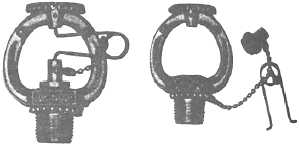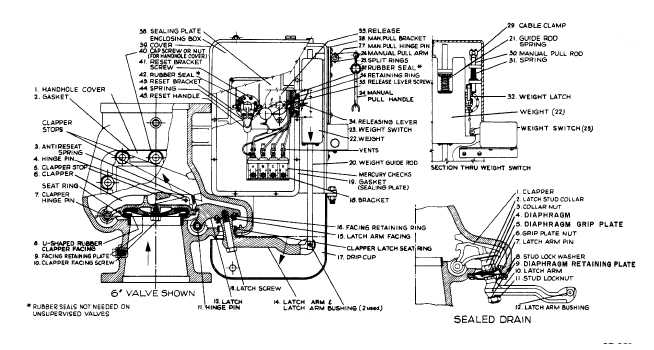valve (fig. 8-10). The water deluge valve remains closed until a fire is detected by a heat-actuated device that in turn causes the valve to open. Heat- actuated devices (H.A.D.) can be either mechanical or electrical in operation. They are discussed in further detail later in this chapter.
The deluge system has a time delay between detection of a fire and the discharge of water at the sprinkler heads. This delay is due to the time required to operate the valve and fill the piping network with water, similar to the dry pipe system. To reduce the delay, the deluge system may be pre-primed by filling the piping network with water downstream from the deluge valve. To prevent water from escaping from the sprinklers, pre-prime plugs (fig. 8-11) are placed on the sprinklers. These plugs blow out of the sprinklers at approximately 20 psi water pressure.
Pre-Action System
A pre-action system differs from a deluge system only in that it has normally closed automatic sprinklers. When the fire detecting device is actuated, the water control valve opens and admits water into the piping system. The system then acts the same as a wet pipe system. Individual sprinklers are opened by the heat of the fire. The advantage of the pre-action system is that the probability of inadvertent water discharge is minimized because operation of both the detection system and automatic sprinklers is necessary for discharge of extinguishing water.
It is incorrect to refer to pre-action systems as dry pipe sprinkler systems. It is true that the pre-action system piping does not contain water. However, the term dry pipe system refers to the type of sprinkler system and the type of water control valve that operates the system.
There are two types of pre-action systems. First is the supervised system, which has air introduced into the system piping at a pressure of approximately 5 psi. This air pressure "supervises" the piping to detect leaks. The pressure switches used for detection of low air pressure on

Figure 8-11.-Sprinkler pre-prime plugs.

Figure 8-10.-Deluge valve.
Continue Reading